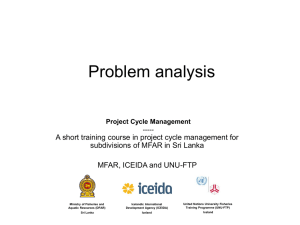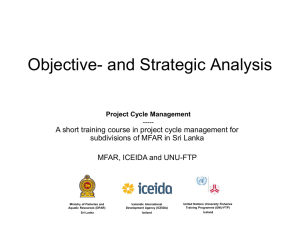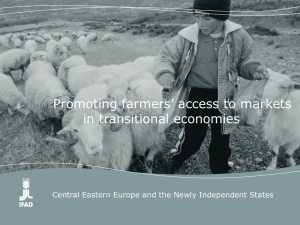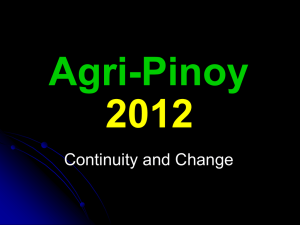Project Cycle Management - United Nations University Fisheries
advertisement
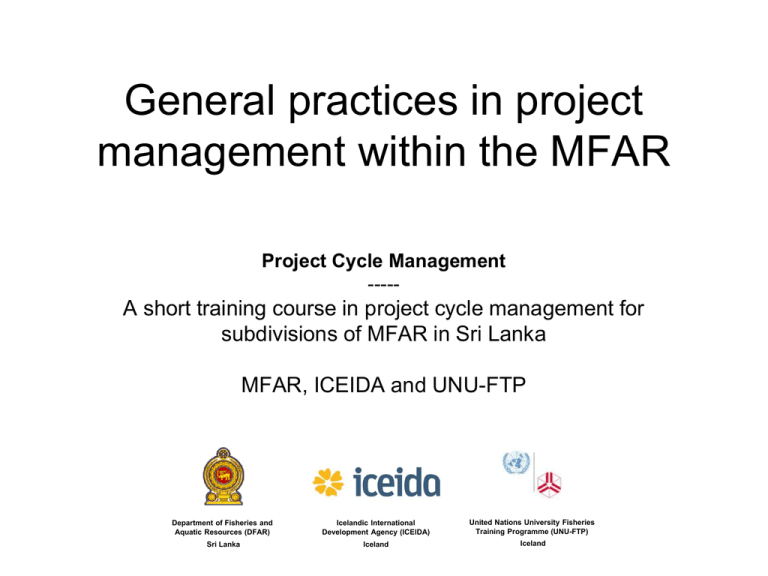
General practices in project management within the MFAR Project Cycle Management ----- A short training course in project cycle management for subdivisions of MFAR in Sri Lanka MFAR, ICEIDA and UNU-FTP Department of Fisheries and Aquatic Resources (DFAR) Icelandic International Development Agency (ICEIDA) United Nations University Fisheries Training Programme (UNU-FTP) Sri Lanka Iceland Iceland Content • General practices in project management within the MFAR • Essential questions behind the visions of the organizations and institutions of MFAR Learning objectives • The participants will be familiar with the structure and missions of institutions, corporations and departments of MFAR • Have knowledge of several internationally funded programmes and projects Institutional structure of MFAR Missions of departments DFAR The sustainable development of fishing industry through sound resource management and the application of new technology in conformity with national and international laws and conventions for making an effective contribution to the national economy of Sri Lanka. CCD The sustainable development of coastal resources and the management of coastal processes to optimize social economic and environmental status of Sri Lanka Missions of corporations CFC CFHC Cey-Nor Objectives Objectives - Planning, Mission - To reach To conduct: -deep sea fishing using its own trawlers. -fish processing and making fishery by products -retail and wholesale trading and distribution. -import and export of fish and related products. development, management and maintenance of harbours, anchorages and costal facilities assuring growth and profitability in accordance with modern technology and conservation of the environment. excellence as a provider of goods and services required by the fishing industry, to maintain quality and customer care and employee satisfaction and to achieve the desired levels of productivity and commercial viability. To build cold rooms and rent the excess capacity to other entrepreneurs. To construct ice plants for production and sale of ice. Missions of institutions NAQDA NARA NIFNE To contribute to the improvement of the socio-economic status of rural fisher communities by alleviating poverty, creating employment opportunities, improving nutritional status and encouraging the greater participation in managing the aquatic resources in a sustainable manner. Conduct scientific research and provide services for the development and sustainable utilization of living and non living aquatic resources. Development of technical and managerial skills of persons engaged in or expecting to be engaged in the industries related to aquatic resources through education and training in efficient and sustainable utilization of aquatic resources Finding the vision of the organization Answering these questions leads us to the vision : • What is our area of activity - what do we do? • Who are our customers/stakeholders? • What are our customers/stakeholders really seeking? • If everything carries on as it has until now, how will our organization be in 5-10 years? • How would we like our organization to be in 5 – 10 years time? Operational structure • Departments, corporations and institutions have autonomy in their day to day operations, as long as they obey national laws, regulations, governmental policy and the policy of MFAR • Therefore the departments, corporations and institutions can operate according to their own standards Operational structure • There is little consistency in co-operative procedures between departments, corporations and institutions • Is that positive or negative? Operational structure • If co-operation is needed between sub divisions of MFAR, the procedure and dialogue are formal between the departments, corporations and institutions and have to go through proper channels • Hence little lateral interlinkages • Is that positive or negative? Types of projects at NARA • Research projects funded by treasury • Externally funded research and development projects • Collaborative research projects • Consultancy studies • Extension programs • Training programmes Examples of current projects NAQDA Projects 1 - Management of inland fisheries Activities District Monitoring of illegal fishing activities in perennial tanks Island wide Special fingerling stocking programs of tanks in the North East Province NE Provinces Special fingerling stocking programs of tanks in Mahiyangana area Badulla 2 - Coastal and brackish water development Monitoring and extension activities of shrimp farming, (issuing of licenses , regularization of unauthorized shrimp farms, increase of shrimp farm area and production, monitoring & control of disease occurrences etc.) Puttalam 3 - Development of shrimp farms in Batticaloa District Construction of shrimp farms and cluster ponds in Batticaloa District Batticaloa Examples of current operations (projects) DFAR Operations Activities Area 1 - Management of costal fisheries Monitoring illegal fisheries e.g. dynamiting, fishing on coral reefs, (1000 cases are being filed by fisheries inspectors), Awareness programs to be conducted National programs 2 - Addressing problems in the high sea fisheries New regulations according to the current situation in fisheries National level 3 - Improvement of socio economic standards of fishing communities and community development programs Formations of fisheries co-operatives in a new vision (Reorganizing of fisheries co-operatives) and introduction of income generating activities in a formal way using PCM National level Foreign funded projects • There are several ongoing foreign funded development projects that being carried out within MFAR • These development projects are funded by agencies such as: • Asian Development Bank (ADB) • International Fund for Agricultural Development (IFAD) • Food and Agriculture Organization of the United Nations (FAO) • Foreign govt. developmental agencies, e.g. ICEIDA, GTZ, SIDA, Govt. of Netherlands and several others Examples of foreign funded projects • Aquatic Resource Development & Quality Improvement Project (ARDQIP) • Coastal Resources Management Project (CRMP) • DEOCOM Project - Project on the delimitation of the outer edge of the continental margin of Sri Lanka under the UNCLOS • Post Tsunami Coastal Rehabilitation and Resource Management Programme • Post Tsunami Livelihood Support and Partnership Programme • Project to replace tsunami affected one-day and multi-day boats IFAD • On 28 of April IFAD launched two multi million USD programs. • Post Tsunami Coastal Rehabilitation and Resource Management Programme. • Post Tsunami Livelihood Support and Partnership Programme. • IFAD uses Logical Framework Approach (LFA) and the Sri Lankan participants will have to adopt and work according to that approach IFAD • Monitoring and evaluation is an important element of IFAD’s LFA • It focuses on a learning approach to management that uses achievements and problems to improve decision-making and accountability • www.ifad.org/evaluation Possible constraints • • • • • • Linguistic Resource management Budget control Multi disciplinary approach Lack of experience Lack of infrastructure Possible strengths • Strong institutional capacity • Co-operation with the industry and fishers’ co-operatives • Increasing governmental interest in the fishery sector • Increased use of information technology (computers) • International development cooperation References • Drucker, Peter (1973). Management: Tasks, Responsibilities and Practices. Transaction Publishers; New Brunswick [USA] and London [U.K] • MFAR (2007). Missions of MFAR downloaded 15th of May from: http://www.fisheries.gov.lk/
